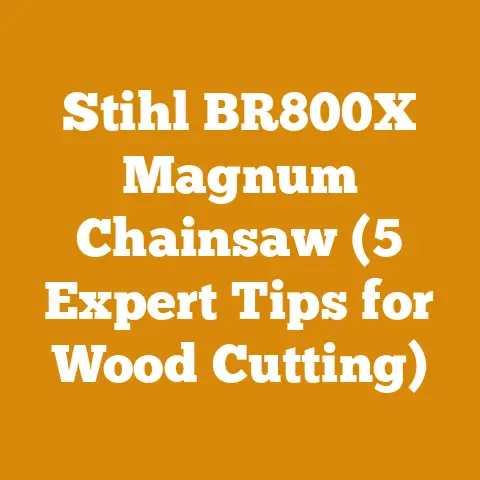Timber Buyers in Missouri: Finding High-Grade Wood Markets (5 Tips)
Are you a Missouri landowner sitting on a gold mine of timber, but unsure how to navigate the often-opaque world of timber buyers?
I understand.
I’ve spent years in the wood processing industry, and I’ve seen firsthand how crucial it is to find the right buyer who will appreciate the true value of your high-grade wood.
This guide is designed to equip you with the knowledge and strategies you need to secure the best possible deal.
Let’s dive in!
Timber Buyers in Missouri: Finding High-Grade Wood Markets (5 Tips)
Understanding the Missouri Timber Market
Before even thinking about contacting timber buyers, it’s essential to understand the lay of the land.
Missouri boasts a diverse range of hardwood species, each with its own unique value and market demand.
Oak, walnut, hickory, and maple are the big players, but other species like ash, cherry, and sycamore can also command premium prices, especially if they’re of exceptional quality.
The price you receive for your timber will depend on several factors:
- Species: As mentioned, different species have different market values.
Walnut, for instance, consistently fetches higher prices than oak due to its desirability for furniture and veneer. - Grade: Timber is graded based on its size, straightness, and the presence of defects like knots, rot, and stain.
High-grade timber, free from significant defects, is highly sought after. - Volume: The total volume of timber you have available for sale will influence the interest of potential buyers.
Larger volumes often attract more competitive bids. - Accessibility: The ease with which loggers can access and harvest your timber will affect the price.
Steep slopes, dense undergrowth, and limited road access can increase harvesting costs and reduce the price offered. - Market Conditions: Like any commodity, timber prices fluctuate based on supply and demand.
Keeping an eye on market trends will help you time your sale for maximum profit.
My Experience: I remember one instance where a landowner in the Ozarks was offered a low price for his oak timber.
He almost accepted it, but I advised him to get a professional timber cruise (an inventory and valuation of standing timber).
The cruise revealed a significant amount of high-grade white oak, which is prized for barrel making.
He ended up getting almost double the initial offer by targeting buyers who specialized in white oak.
Key Takeaway: Knowledge is power.
Understanding the factors that influence timber prices will empower you to negotiate effectively and avoid being taken advantage of.
Tip 1: Get a Professional Timber Cruise
The single most important step in finding high-grade wood markets is to get a professional timber cruise.
A timber cruise is an inventory and appraisal of your standing timber, conducted by a qualified forester or timber consultant.
This cruise will provide you with a detailed report that includes:
- Species Identification: A breakdown of the different tree species present on your property.
- Diameter at Breast Height (DBH): The diameter of each tree measured at 4.5 feet above ground level.
This is a standard measurement used to estimate timber volume. - Tree Height: The height of each tree, used to calculate timber volume.
- Grade Assessment: An evaluation of the quality of each tree, based on its size, straightness, and the presence of defects.
Timber is typically graded according to standards established by organizations like the National Hardwood Lumber Association (NHLA). - Volume Estimation: An estimate of the total volume of timber, usually expressed in board feet.
A board foot is a unit of measurement equal to 1 inch thick, 12 inches wide, and 12 inches long. - Market Value Appraisal: An estimate of the current market value of your timber, based on species, grade, volume, and prevailing market prices.
Why is a Timber Cruise Essential?
- Accurate Valuation: A timber cruise provides an objective and accurate assessment of the value of your timber.
This information is crucial for negotiating with timber buyers. - Identifying High-Grade Timber: A professional cruiser can identify high-grade timber that might be overlooked by an untrained eye.
This can significantly increase the value of your timber sale. - Protecting Your Interests: A timber cruise protects you from being underpaid for your timber.
It gives you the knowledge and confidence to negotiate a fair price. - Sustainable Forest Management: A timber cruise can also help you develop a sustainable forest management plan, ensuring the long-term health and productivity of your timberland.
Finding a Qualified Timber Cruiser:
- State Forestry Agencies: Contact your state forestry agency (in Missouri, the Missouri Department of Conservation) for a list of qualified foresters and timber consultants.
- Professional Organizations: Look for members of professional organizations like the Society of American Foresters (SAF) or the Association of Consulting Foresters (ACF).
- References: Ask for references from previous clients and check their credentials and experience.
Cost of a Timber Cruise:
My Insight: During a timber cruise I conducted in southern Missouri, I discovered a pocket of exceptionally straight and knot-free black walnut trees.
The landowner had no idea he had such valuable timber on his property.
The timber cruise allowed him to market this walnut specifically to veneer buyers, resulting in a much higher price than he would have received otherwise.
Actionable Metric: Aim for a timber cruise report that breaks down the volume and value of your timber by species and grade.
This level of detail will be invaluable during negotiations.
Key Takeaway: Invest in a professional timber cruise.
It’s the foundation for a successful timber sale.
Don’t skip this step!
Tip 2: Research and Identify Potential Timber Buyers
Once you have a timber cruise report in hand, it’s time to start researching and identifying potential timber buyers.
Not all timber buyers are created equal.
Some specialize in certain species or grades of timber, while others are more generalists.
It’s important to find buyers who are actively seeking the type of timber you have to offer.
Types of Timber Buyers:
- Sawmills: Sawmills process logs into lumber.
They are typically interested in a wide range of species and grades, but they may pay less for high-grade timber than buyers who specialize in specific applications. - Veneer Mills: Veneer mills produce thin sheets of wood that are used to cover furniture, cabinets, and other products.
They are primarily interested in high-grade hardwood logs, particularly walnut, cherry, and maple. - Export Buyers: Export buyers purchase logs for shipment to overseas markets.
They often focus on high-value species and grades. - Log Brokers: Log brokers act as intermediaries between landowners and timber buyers.
They can help you find buyers for your timber, but they will typically take a commission on the sale. - Pulp and Paper Mills: Pulp and paper mills use wood chips and other wood fiber to produce paper and other products.
They are typically interested in lower-grade timber and pulpwood.
Finding Timber Buyers:
- State Forestry Agencies: Your state forestry agency (Missouri Department of Conservation) can provide you with a list of licensed timber buyers in your area.
- Industry Associations: Contact industry associations like the Missouri Forest Products Association (MFPA) for a directory of timber buyers and processors.
- Online Directories: Use online directories and search engines to find timber buyers in Missouri.
- Networking: Talk to other landowners, foresters, and loggers in your area to get recommendations.
Qualifying Timber Buyers:
Once you have a list of potential buyers, it’s important to qualify them to ensure they are reputable and capable of fulfilling their obligations.
Consider the following factors:
- License and Insurance: Make sure the buyer is properly licensed and insured.
This will protect you in case of accidents or damage to your property. - Financial Stability: Check the buyer’s financial stability to ensure they can pay you for your timber.
- Reputation: Ask for references from previous clients and check their reputation in the industry.
- Contract Terms: Review the buyer’s contract terms carefully to ensure they are fair and reasonable.
- Harvesting Practices: Inquire about the buyer’s harvesting practices to ensure they are environmentally sound and will minimize damage to your property.
My Story: I once worked with a landowner who was approached by an out-of-state timber buyer offering a seemingly incredible price for his walnut timber.
However, the buyer refused to provide references or proof of insurance.
We did some digging and discovered that the buyer had a history of leaving messes and failing to pay landowners in full.
The landowner dodged a bullet by doing his due diligence.
Actionable Metric: Aim to contact at least five potential timber buyers to get competitive bids for your timber.
Key Takeaway: Don’t settle for the first offer you receive.
Research and qualify multiple timber buyers to ensure you’re getting the best possible deal.
Tip 3: Request and Evaluate Bids Carefully
Now that you’ve identified potential timber buyers, it’s time to request bids for your timber.
The bidding process is crucial for maximizing your return.
Preparing a Bid Package:
- Timber Cruise Report: This is the most important document in the bid package.
It provides detailed information about the species, grade, and volume of your timber. - Property Map: A map showing the location of your property and the boundaries of the timber sale area.
- Harvesting Restrictions: Any restrictions on harvesting activities, such as limitations on the use of heavy equipment or requirements for erosion control.
- Payment Terms: Your preferred payment terms, such as a lump-sum payment or payment based on volume harvested.
- Bid Deadline: A clear deadline for submitting bids.
Requesting Bids:
- Contact Buyers Directly: Contact each potential buyer directly and invite them to submit a bid.
- Provide Ample Time: Give buyers ample time to inspect your timber and prepare their bids.
Two to four weeks is a reasonable timeframe. - Answer Questions: Be available to answer any questions buyers may have about your timber or property.
Evaluating Bids:
Once you’ve received bids, it’s time to evaluate them carefully.
Don’t focus solely on the highest bid.
Consider the following factors:
- Price: The total price offered for your timber.
- Payment Terms: The payment terms offered by the buyer.
A lump-sum payment is generally preferred, as it provides you with immediate cash flow and eliminates the risk of being underpaid. - Harvesting Practices: The buyer’s harvesting practices.
Choose a buyer who will harvest your timber in an environmentally sound manner and minimize damage to your property. - Contract Terms: The contract terms offered by the buyer.
Review the contract carefully to ensure it is fair and reasonable. - Reputation: The buyer’s reputation.
Choose a buyer with a proven track record of honesty and integrity.
Negotiating Bids:
Don’t be afraid to negotiate with potential buyers.
If you receive multiple bids, you can use them to leverage a better price or more favorable terms.
My Experience: I recall a landowner in central Missouri who received two bids for his oak timber.
One bid was slightly higher, but the buyer had a reputation for being difficult to work with.
The other bid was lower, but the buyer had a stellar reputation and offered more favorable payment terms.
The landowner ultimately chose the lower bid, knowing that he would have a smoother and more reliable experience.
Actionable Metric: Create a spreadsheet to compare bids side-by-side, focusing on price, payment terms, harvesting practices, and contract terms.
Key Takeaway: Evaluating bids is about more than just the highest number.
Consider all factors to choose the best overall fit for your needs and priorities.
Tip 4: Negotiate a Strong Timber Sale Contract
A well-written timber sale contract is essential for protecting your interests and ensuring a smooth and successful timber sale.
The contract should clearly define the terms and conditions of the sale, including:
- Parties Involved: The names and addresses of the seller (you) and the buyer.
- Property Description: A detailed description of the property where the timber is located.
- Timber Description: A clear description of the timber being sold, including species, grade, and volume.
- Price and Payment Terms: The price being paid for the timber and the payment terms.
- Harvesting Period: The time period allowed for harvesting the timber.
- Harvesting Restrictions: Any restrictions on harvesting activities, such as limitations on the use of heavy equipment or requirements for erosion control.
- Access Rights: The buyer’s right to access the property for harvesting purposes.
- Insurance Requirements: The buyer’s insurance requirements.
- Liability: The buyer’s liability for any damage to your property.
- Dispute Resolution: The procedures for resolving any disputes that may arise.
- Termination Clause: The conditions under which the contract can be terminated.
Key Contract Provisions:
- Performance Bond: Consider requiring the buyer to post a performance bond to ensure they fulfill their obligations under the contract.
- Lump-Sum Payment: Insist on a lump-sum payment rather than payment based on volume harvested.
This will protect you from being underpaid. - Clearly Defined Harvesting Area: Clearly define the harvesting area in the contract and on the ground to prevent the buyer from cutting timber outside the designated area.
- Damage Clause: Include a clause that holds the buyer liable for any damage to your property, including roads, fences, and watercourses.
- Erosion Control: Require the buyer to implement erosion control measures to protect water quality.
- Re-Seeding Clause: Include a clause that requires the buyer to re-seed any disturbed areas after harvesting.
Legal Review:
It’s highly recommended that you have a lawyer review the timber sale contract before you sign it.
A lawyer can help you identify any potential pitfalls and ensure that the contract protects your interests.
My Story: I once witnessed a landowner who signed a timber sale contract without having it reviewed by a lawyer.
The contract was poorly written and contained several loopholes that allowed the buyer to exploit him.
The landowner ended up receiving significantly less money for his timber than he expected.
Actionable Metric: Spend at least 2-3 hours reviewing the timber sale contract with your lawyer to ensure you understand all its terms and conditions.
Key Takeaway: A strong timber sale contract is your shield.
Don’t compromise on its quality and clarity.
Get legal advice!
Tip 5: Supervise the Harvest and Ensure Compliance
Once you’ve signed the timber sale contract, it’s important to supervise the harvest to ensure the buyer complies with the terms of the contract.
Regular Inspections:
- Visit the Site Regularly: Visit the harvesting site regularly to monitor the buyer’s progress and ensure they are adhering to the contract terms.
- Document Progress: Take photos and videos to document the harvesting progress.
- Communicate with the Buyer: Maintain open communication with the buyer and address any concerns promptly.
Compliance Issues:
Be on the lookout for the following compliance issues:
- Cutting Outside the Designated Area: Ensure the buyer is not cutting timber outside the designated harvesting area.
- Damage to Property: Monitor for any damage to your property, including roads, fences, and watercourses.
- Erosion Control: Ensure the buyer is implementing erosion control measures to protect water quality.
- Littering: Ensure the buyer is not littering on your property.
Addressing Non-Compliance:
If you discover any instances of non-compliance, take the following steps:
- Document the Issue: Document the issue with photos and videos.
- Notify the Buyer: Notify the buyer in writing of the non-compliance issue.
- Demand Corrective Action: Demand that the buyer take corrective action to address the issue.
- Consult with Your Lawyer: If the buyer fails to take corrective action, consult with your lawyer to determine your legal options.
Final Inspection:
Once the harvest is complete, conduct a final inspection of the property to ensure the buyer has met all the terms of the contract.
My Insight: I once worked with a landowner who discovered that a timber buyer was cutting trees outside the designated harvest area.
The landowner immediately notified the buyer in writing and demanded that they stop.
The buyer initially refused, but the landowner threatened to sue them.
The buyer eventually backed down and agreed to pay for the timber that was cut illegally.
Actionable Metric: Aim to visit the harvesting site at least once a week during the harvesting period to monitor compliance.
Key Takeaway: Your involvement doesn’t end with the contract.
Active supervision ensures the agreement is honored and your property is protected.
Conclusion:
Selling timber, especially high-grade wood, in Missouri requires careful planning, research, and execution.
By following these five tips, you can significantly increase your chances of finding the right timber buyer and securing the best possible deal for your valuable resource.
Remember to prioritize professional advice, thorough research, and a strong contract.
Good luck!






